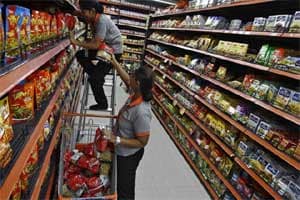The year 2016 could well be a very significant milestone for Indian consumers and Indian retail (modern as well
as traditional). What can we expect that would be different in 2016 than what it has been in 2015? Before we can speculate on this, two caveats have to be kept in mind.
The first is that after two successive failed monsoons, the next year will see a very good spatial and temporal distribution of rains. After the strongest El Nino in 100 years in 2015, some early reports have already speculated that 2016 could see a very strong La Nina and hopefully, that would translate into good rains for India and thereby provide a much-needed fillip to rural demand and provide a much needed headwind to the overall growth of the economy.
The second (and a bigger one) is that the central government will finally shed in 2016 its “ostrich-in-the-sand” ideology relating to global investment in retail and to investment per se in e-tail, and come out with a 21st-century contemporary policy on retail that does not differentiate between modern retail and traditional retail, or foreign ownership and domestic ownership, or physical retail and digital retail. India needs an efficient, modern, producer-consumer-centric retail ecosystem with minimal levels of intermediation (and its associated costs and wastages).
For more than two decades, governments have been bogged down by a singular facet — the country of origin of investment into this sector — rather than focusing on making the overall producer-consumer value chain efficient and vibrant.
With these two caveats out of the way, what would be different about consumers in 2016? There are two fundamental changes that have been under way for several years now but will perhaps reach a turning point in 2016. Firstly, for most urban middle- and upper-income consumers, the most important personal resource is “time”. Multiple socio-economic-lifestyle factors have put even more pressure on availability of time for most urban consumers and therefore they are continuously striving for solutions and options that can help them save some time, or make a more efficient usage of their time. That creates opportunities across the board in just about every facet of consumer spending — both merchandise and services — to come up with platforms that provide this time efficiency to the consumers. 2016 will therefore see a much sharper shift of Indian consumers to use smart, technology-enabled platforms to buy a wide range of goods and services (including financial services, food services, and even healthcare services) creating an unprecedented wave of disruption for some of the most well established but traditionally-organised business entities. With this onslaught of new options of goods and services, the consumers are increasingly becoming more flirtatious and thereby more comfortable with trying new, unknown “brands” and “labels” from “new platforms”, thereby leading to rapidly reducing brand loyalty for both the product as well as the channel. In a way, we can therefore see the rise of a far more confident, more individualistic, more risk-taking consumer in 2016 than ever in the past.
The second very fundamental change is indirectly related to this more confident, more risk-taking, time-poorer consumer (across different socio-economic strata other than the poor and low-income consumer groups). This consumer seems to be more comfortable being an “Indian” rather than merely being an aspirant and an imitator of West-influenced brands and lifestyles. Enough has been written about the spectacular success of Patanjali products that have a clear in-your-face message of “swadeshi” versus “videshi” (national versus foreign) but there are many other examples of successes across multiple businesses such as Fabindia and Organic India, W and others, the entire wedding industry, the success of “private labels” on e-platforms such as Myntra, physical and digital food, and food services businesses such as Haldiram’s, Bikanerwala, Chaayos, Faasos, Hector Beverages’ Paper Boat range of beverages etc. Indeed, 2016 could see this trend accelerating with more entrepreneurs launching a much broader range of businesses focusing on “Indian tradition”-inspired products including many in apparel, home including kitchen, skin & body care, health & wellbeing, nutraceutical and dietary supplements, etc.
All of this activity (stronger economic growth, removal of restrictions on international investment in the retail sector, changing consumer priorities, and time-poverty being some of the most visible one) will lead to an even more intense battle for consumers’ wallet (physical and digital). The battle would be intense both for the manufacturers/brand-owners and marketers of consumer products & services, and for the channel (traditional, modern physical, and modern digital). With the imminent entry of Reliance Jio in the already crowed “marketplace” channel that has seen Amazon, Flipkart, Snapdeal and Paytm already engaged in a bruising battle, 2016 promises to be a truly “achhe din” year for Indian consumers with a further proliferation in product options, in channels, and even more aggressive discounting than in the recent past. Both for brand-owners and the modern retailers (physical and digital), 2016 could well decide who will be able to survive by 2020 (or in some cases, even by 2018).
Arvind Singhal is Chairman & MD, Technopak


